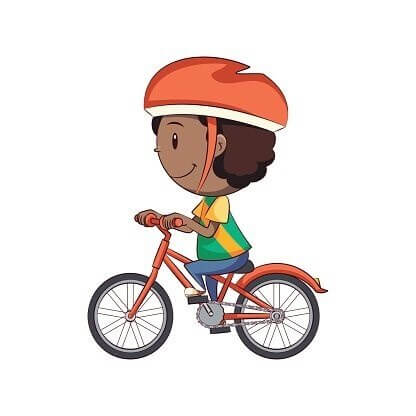Scooters are a lot of fun to ride, but it is easy for kids to get hurt. Nearly 85 percent of the injuries occurred to children under 15 years of age.
More than 60 percent of injuries could be prevented or reduced in severity if protective safety gear is worn.
Scooter Safety Tips
- Supervise children ages 8 and under when they ride scooters.
- Give your child’s scooter a safety check each time before he rides. Check that the handlebars and steering column are locked in place. Check for loose, broken or cracked parts. Make sure all nuts and bolts are secure.
- Make sure your child knows the scooter’s capabilities, and how to control speed, turn and stop.
- Make your children wear safety gear at all times, including a helmet, wrist guards, and elbow and knee pads. Ensure the gear fits properly and does not interfere with the child’s vision, movement or hearing.
- Do not let your child ride barefoot. Shoes with rubber soles provide good traction.
- Encourage children to ride their scooters on smooth, dry, paved surfaces.
- Tell them to avoid riding on gravel, sand, dirt or other uneven surfaces.
- Caution children to watch out for wet or oily surfaces, which are slippery.
- Allow only one person on a scooter at a time.
- Never let your child ride his scooter in the street or on busy sidewalks.
- Never let a child hitch a ride by holding on to a moving car or other vehicle.
- Teach your child to obey city laws and the Rules of the Road.
- Tell your child to walk his scooter down steep hills.
- Do not let children ride scooters at night.
- Help your child learn to fall by practicing on a soft surface or in the grass.
Teach Your Child to do the Following if They Fall
-
Roll with the fall.
-
Relax. Do not stiffen up.
-
Land on the fleshy parts of the body.
-
Do not try to absorb the force of the fall with your arms. Most fracture and dislocation injuries from scooters are to the arms and hands.
Inline Skating
Also known as roller blades, inline skates are roller skates with wheels in a line as opposed to being side-by-side. The position of the wheels allows for faster speeds and sharper turns. Since gaining popularity in the early 1990’s, inline skating has become a great way to get exercise and enjoy the outdoors, but kids can get hurt if they are not safe.
Inline Skating Safety Tips
- Always wear a helmet specifically designed for inline skating. These helmets extend down lower in the back, toward the base of the skull. This provides better protection than a bike helmet in the event of falling backwards. According to the American Academy of Pediatrics, 10,000 in-line skaters suffer head or face injuries yearly from not wearing appropriate safety gear.
- Skates should fit properly and be free of debris. If worn out from use, replace the wheels.
- Elbow pads can reduce injuries by 80%; knee pads can reduce injuries by 30%; and wrist guards can reduce injuries by almost 90%.
- A mouth guard can protect against broken teeth in the event of a fall.
- Children younger than 5 years should not ride on inline skates; children ages 6 to 10 years should have close adult supervision when inline skating.
- Always put on protective gear before putting on your skates.
- Stretch and warm-up properly before and after skating.
- Beginners should consider learning in obstacle free spaces and learn how to fall properly.
- Having grass beside your practice area is ideal as it offers a soft place to fall when learning.
- Do not skate at night or in dark conditions.
- Always be aware of your environment: other skaters, pedestrians, cars, bikers and others.
- Avoid skating in crowded areas.
- Do not skate while distracted. Wearing earbuds or headphones can cause an accident with others.
- When skating, keep to the far-right side of sidewalks, bike paths and trails.
- Communicate with others when passing.
Skateboarding
An increasingly popular, yet risky sport, skateboarding was made an official Olympic sport back in 2020.
Longboards 42-80 inches long allows riders to achieve speeds more than 30 mph; riding downhill can result in faster speeds and increases the risk of injury. According to the American Academy of Pediatrics, longboards have unique safety issues and resulting injuries can be more severe than a skateboard injury.
Skateboarding Safety Tips
- Always wear a helmet that meets Consumer Product Safety Commission standards.
- ASTM F1492 or Snell N-94 means helmet was specially designed to protect people who skateboard, longboard or inline/roller skate.
- Make sure to wear protective gear such as wrist guards, knee and elbow pads, goggles and closed toe shoes with flat soles.
- Children under age 5 should not ride skateboards or longboards.
- Children ages 5-10 should be supervised by an adult.
- Always check that your wheels and board are secure before skating.
- Learn to Fall
- If you’re losing control, crouch down so you don’t have as far to fall.
- Try to land on fleshy parts of your body.
- Try to roll rather than absorbing the force with your arms.
- Try to relax your body rather than being stiff.
- Practice falling on a soft surface or grass.
- Obey local laws on where you can skate.
- Never ride in the street.
- Do not use headphones when skateboarding.
- Never hang on to a car or bike when skateboarding.
- In a multi-use area, skate on the right and pass on the left.









